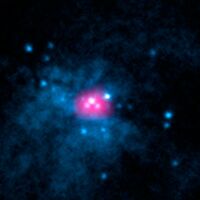Astronomy:M82 X-2
| Observation data Equinox J2000.0]] (ICRS) | |
|---|---|
| Constellation | Ursa Major |
| Right ascension | 09h 55m 51.0s |
| Declination | 69° 40′ 45″ |
| Astrometry | |
| Distance | 12 million ly (3.5 million pc) |
| Other designations | |
| Database references | |
| SIMBAD | data |
M82 X-2 is an X-ray pulsar located in the galaxy Messier 82, approximately 12 million light-years from Earth.[2] It is exceptionally luminous, radiating energy equivalent to approximately ten million Suns. This object is part of a binary system: If the pulsar is of an average size, 1.4 M☉, then its companion is at least 5.2 M☉.[3] On average, the pulsar rotates every 1.37 seconds, and revolves around its more massive companion every 2.5 days.[4]
M82 X-2 is an ultraluminous X-ray source (ULX), shining about 100 times brighter than theory suggests something of its mass should be able to. Its brightness is many times higher than the Eddington limit, a basic physics guideline that sets an upper limit on the brightness that an object of a given mass should be able to achieve. Possible explanations for violations of the Eddington limit include geometrical effects arising from the funneling of in-falling material along magnetic field lines.
While M82 X-2 was previously known as an X-ray source, it was not until an observation campaign to study the newly discovered supernova SN 2014J in January 2014 that X-2's true nature was uncovered.[5][6] Scientists looking at data from the NuSTAR spacecraft noticed a pulsing in the X-ray spectrum coming from near the supernova in Messier 82.[2][7] Data from the Chandra and Swift spacecraft was used to verify the NuSTAR findings and provide the necessary spatial resolution to determine the exact source.[3][4] After combining the NuSTAR and Chandra data, scientists were able to discern that M82 X-2 emitted both an X-ray beam and continuous broad X-ray radiation.[1] LXs). In 2023 new NuSTAR data confirmed that it exceeded the Eddington limit.[8][9]
See also
References
- ↑ Jump up to: 1.0 1.1 Smith et al. 1995, p. 204.
- ↑ Jump up to: 2.0 2.1 Stark, Anne M. (9 October 2014). "Dead star shines on". Lawrence Livermore National Laboratory. Archived from the original on 11 October 2014. https://web.archive.org/web/20141011095722/https://www.llnl.gov/news/aroundthelab/2014/Oct/ATL100914_star.html. Retrieved 11 October 2014.
- ↑ Jump up to: 3.0 3.1 Anderson, Janet; Watzke, Megan (8 October 2014). "Suspected Black Hole Unmasked as Ultraluminous Pulsar". NASA. Archived from the original on 16 October 2014. https://web.archive.org/web/20141016010015/http://www.nasa.gov/chandra/news/ultraluminous_pulsar.html. Retrieved 19 October 2014.
- ↑ Jump up to: 4.0 4.1 Smith et al. 1995, p. 202.
- ↑ Fesenmaier, Kimm (8 October 2014). "NuSTAR Discovers Impossibly Bright Dead Star". Caltech. Archived from the original on 16 October 2014. https://web.archive.org/web/20141016040751/http://www.caltech.edu/content/nustar-discovers-impossibly-bright-dead-star. Retrieved 19 October 2014.
- ↑ Fesenmaier, Kimm (9 October 2014). "Pulsar as bright as 10 million suns baffles astronomers". Futurity. Archived from the original on 20 October 2014. https://web.archive.org/web/20141020052208/http://www.futurity.org/pulsar-bright-779792/. Retrieved 19 October 2014.
- ↑ Chou, Felicia; Clavin, Whitney (8 October 2014). "NASA's NuStar Telescope Discovers Shockingly Bright Dead Star". NASA. Archived from the original on 26 October 2014. https://web.archive.org/web/20141026171350/http://www.nasa.gov/press/2014/october/nasa-s-nustar-telescope-discovers-shockingly-bright-dead-star/. Retrieved 26 October 2014.
- ↑ Bachetti, Matteo; Heida, Marianne; Maccarone, Thomas; Huppenkothen, Daniela; Israel, Gian Luca; Barret, Didier; Brightman, Murray; Brumback, McKinley et al. (2022-10-01). "Orbital Decay in M82 X-2". The Astrophysical Journal 937 (2): 125. doi:10.3847/1538-4357/ac8d67. ISSN 0004-637X. Bibcode: 2022ApJ...937..125B.
- ↑ "NASA Study Helps Explain Limit-Breaking Ultra-Luminous X-Ray Sources" (in en-US). https://www.jpl.nasa.gov/news/nasa-study-helps-explain-limit-breaking-ultra-luminous-x-ray-sources.
Bibliography
- Bachetti, M.; Harrison, F. A.; Walton, D. J.; Grefenstette, B. W.; Chakrabarty, D. et al. (9 October 2014). "An ultraluminous X-ray source powered by an accreting neutron star". Nature 514 (7521): 202–204. doi:10.1038/nature13791. PMID 25297433. Bibcode: 2014Natur.514..202B.
 |


